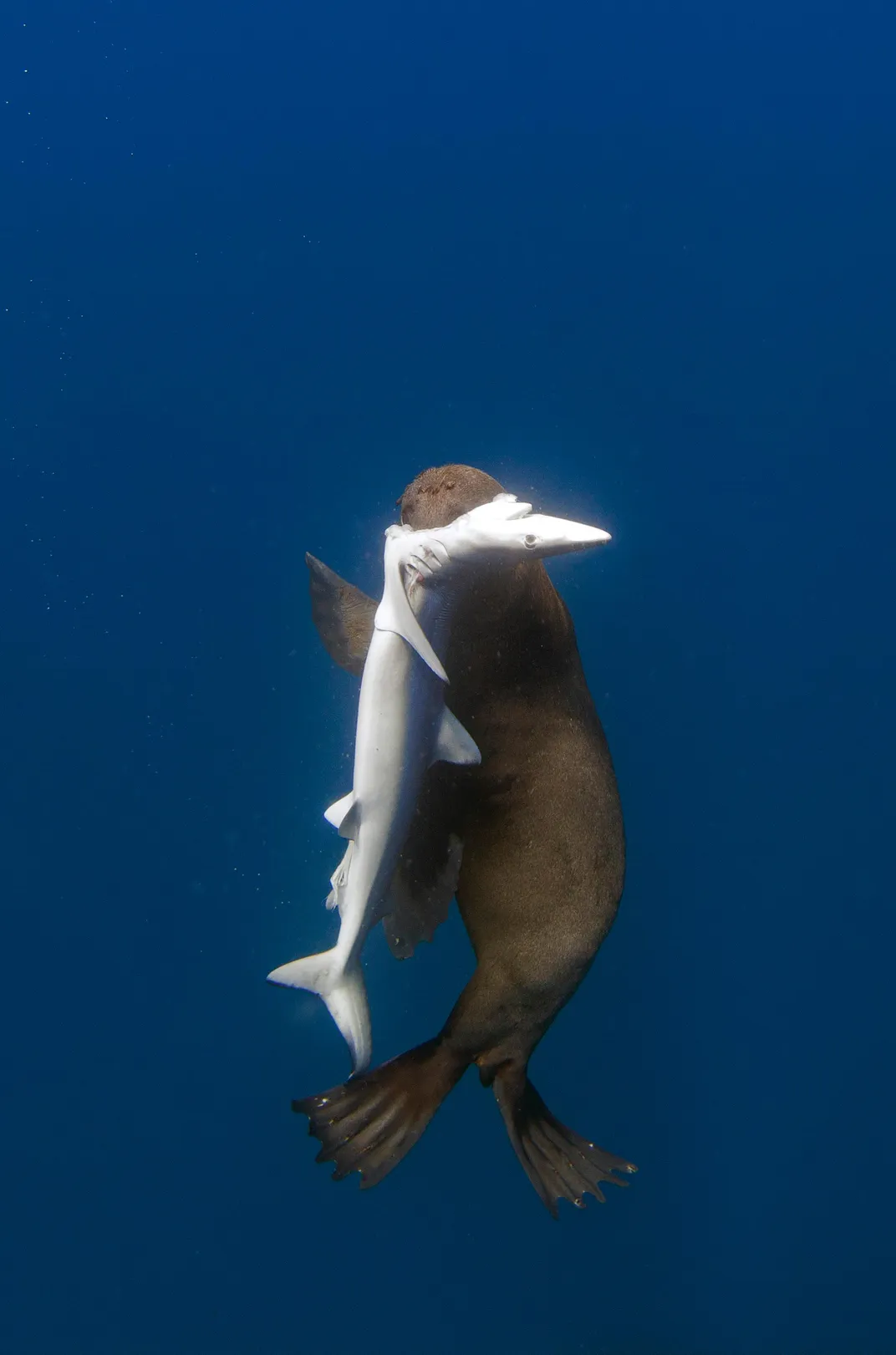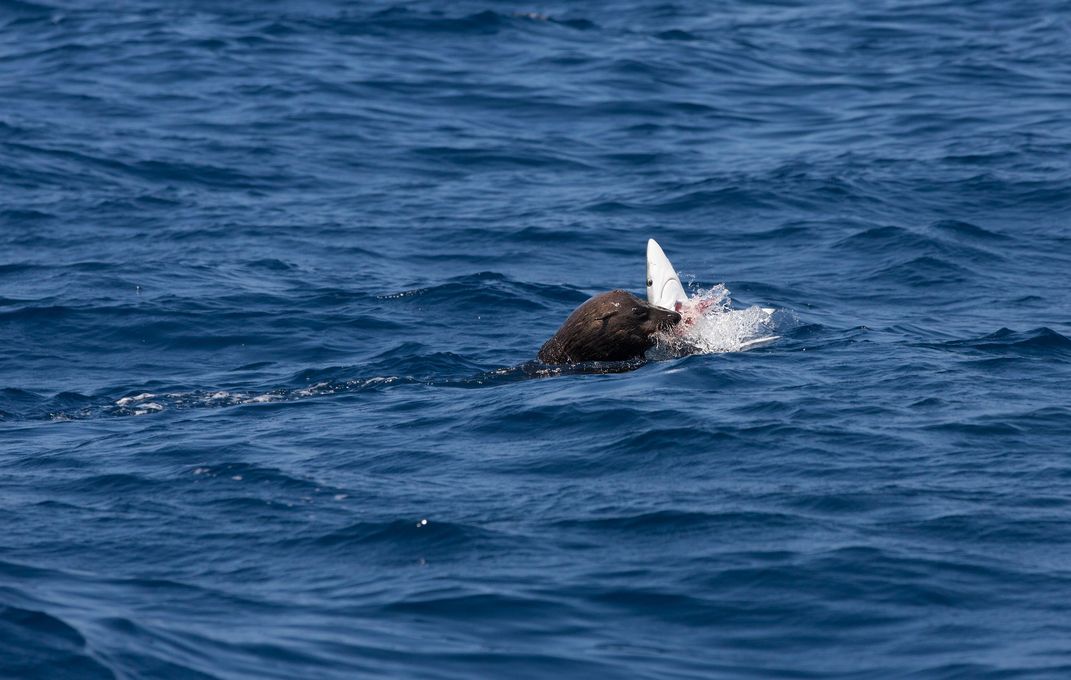Fur Seals Caught Preying on Sharks Off South Africa
The seals only consume the viscera, though, which may be why this particular type of predation took ecologists by surprise
/https://tf-cmsv2-smithsonianmag-media.s3.amazonaws.com/filer/20/5e/205e8b13-c100-4deb-92ef-d8e571624e27/img_0666.jpg)
From Jaws to Finding Nemo, sharks are most often portrayed as ravenous eaters. But even for these fierce marine predators, sometimes the hunters become the hunted. Photos taken during a 2012 tourist trip in South Africa are the only known documentation of a seal going after and consuming mid-sized to large sharks, according to a study published online last week in the African Journal of Marine Sciences. The discovery not only reveals a previously hidden part of one species' diet, it could also have important implications for our understanding of the food web in the open ocean.
Chris Fallows has been working with sharks since 1992, when commercial cage diving first came to South Africa. Today he runs a diving operation called Apex Shark Expeditions, and he regularly spends up to 200 days per year at sea, tracking and observing his favorite marine predators. Fallows knows his sharks, which is why the events of December 2012 struck him as exceeding odd.
At the time, Fallows was leading a group of tourists on a run-of-the-mill shark dive 20 nautical miles southwest of Cape Point, the peninsula that curves out of Cape Town like a fishhook. Things were going well: ten blue sharks, attracted to the fishy bait Fallows had set, turned up at the scene. Abruptly, however, a male Cape fur seal—not quite fully grown—swam into the predatory assembly.
Common prey of great white sharks, Cape fur seals normally feast on small fish, squid and crabs. But instead of going for the bait, this young seal turned its ravenous attention to the blue sharks, some of which were up to 4.5 feet long, or about the same size as the seal. The seal first snatched one shark, tearing open its abdominal cavity and feeding on the dark viscera inside. Then it went for another, and another. Fearing for his tourists’ safety, Fallows sent them back to the vessel. But he stayed to witness the scene, photographing the seal as it killed and consumed five of the ten sharks. He left before the seal had finished its meal, afraid that his presence was somehow aggravating the situation. “Sharks of this size are certainly not usually considered food for seals,” Fallows said at the time.

However, this was not the first time Fallows had witnessed such a scene. In 2004, while cruising on the open water near Cape Point, he spotted a seal—also a young male—pursuing and catching a blue shark. The seal tossed the shark into the air before eating its stomach and liver. Fallows wasn’t able to get high-quality photos of that event, but this time he had plenty. His photos posted online attracted a few headlines, one of which was spotted by Hugues Benoit, a fisheries scientist at Fisheries and Oceans Canada. “I saw these images—beautiful images—and contacted Chris,” Benoit says. “I wasn’t sure if he understood the scientific importance of what he had seen.”
In the new paper, Fallows, Benoit and Neil Hammerschlag at the University of Miami describe the event and its ecological significance. Seals have been seen before occasionally picking off a baby shark or nibbling on a dead shark trapped in a fishing net. But while Cape fur seals and blue sharks have similar diets, seals were not previously known to turn on their predatory rivals. “This is a case where one competitor sort of got the upper hand,” Benoit says.
The seal’s picky consumption of only the viscera, the most energy-dense part of the shark, is also noteworthy. Although fishers have noted for years that seals sometimes eat the viscera of large fish trapped in their nets, this type of predation has rarely been documented properly in free-swimming prey that fall victim to marine mammals. The fact that the seal discarded the rest of its catch shows that it had the option to be picky and is probably not at a loss for food. “It’s like being at a lobster buffet,” Benoit says. “If there’s tons of lobsters around, you just eat the tails and claws instead of dealing with all the little legs.”

The behavior also suggests that traditional methods of diet estimation for marine mammals might be missing some key strands in the food web. Ecologists have long assumed that seals consume mainly small fish not exceeding about a foot long. But analyzing seal diets usually entails looking at what’s found in their guts or in their feces, which in turn depends on recovering hard parts such as fish ear bones. If seals are selectively eating viscera from sharks—or any other large animal—that slippery evidence would have evaded scientists’ detection methods, potentially leading to a biased picture of who’s eating whom.
Finally, predators that are only targeting viscera instead of the whole animal can have population-level consequences for the prey, because they have to kill so many animals to get their fill. For now, that's a harder conclusion to draw for blue sharks, because the researchers cannot estimate how many are being eaten by seals based on just two observations. Still, Benoit suspects that shark-eating is a natural behavior for the seals, given that Fallows first witnessed it in open water where no human activity might somehow be egging on an abnormal interaction. Fallows was also “impressed at the ease with which this seal was able to take these sharks,” Benoit says, implying that this wasn’t the seal’s first shark-gobbling rodeo.
“Presumably, this kind of behavior would be rare enough that the observer would just have to be at the right place at the right time,” Benoit says. “Although this is just a few observations, it shows that, in some instances, human observers can overcome the somewhat improbably odds of capturing these kind of events on film.”
/https://tf-cmsv2-smithsonianmag-media.s3.amazonaws.com/accounts/headshot/Rachel-Nuwer-240.jpg)
/https://tf-cmsv2-smithsonianmag-media.s3.amazonaws.com/accounts/headshot/Rachel-Nuwer-240.jpg)